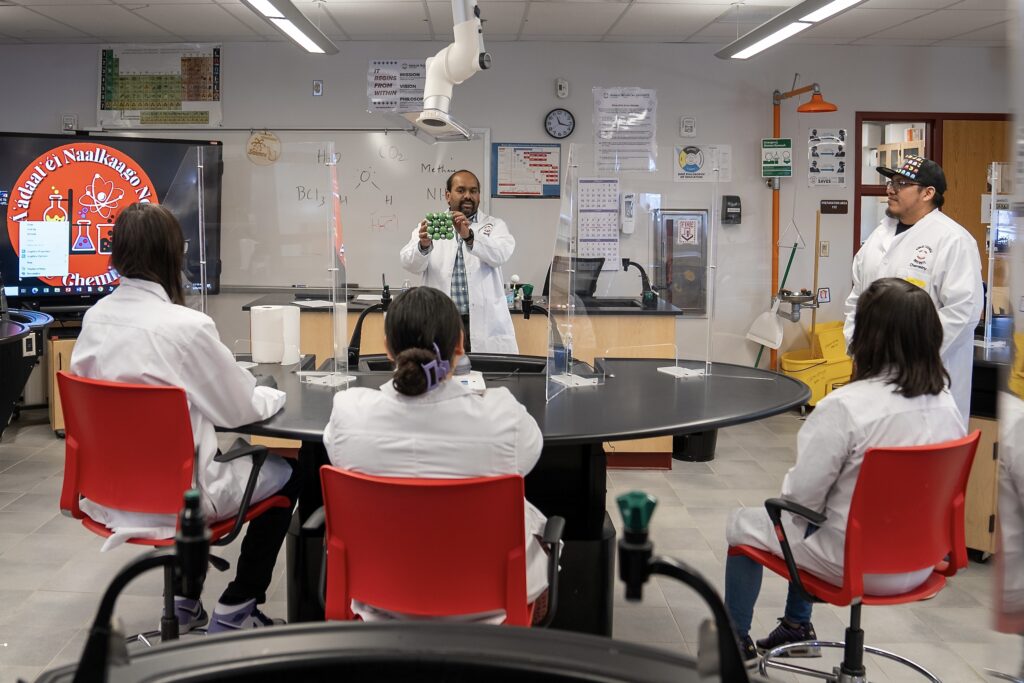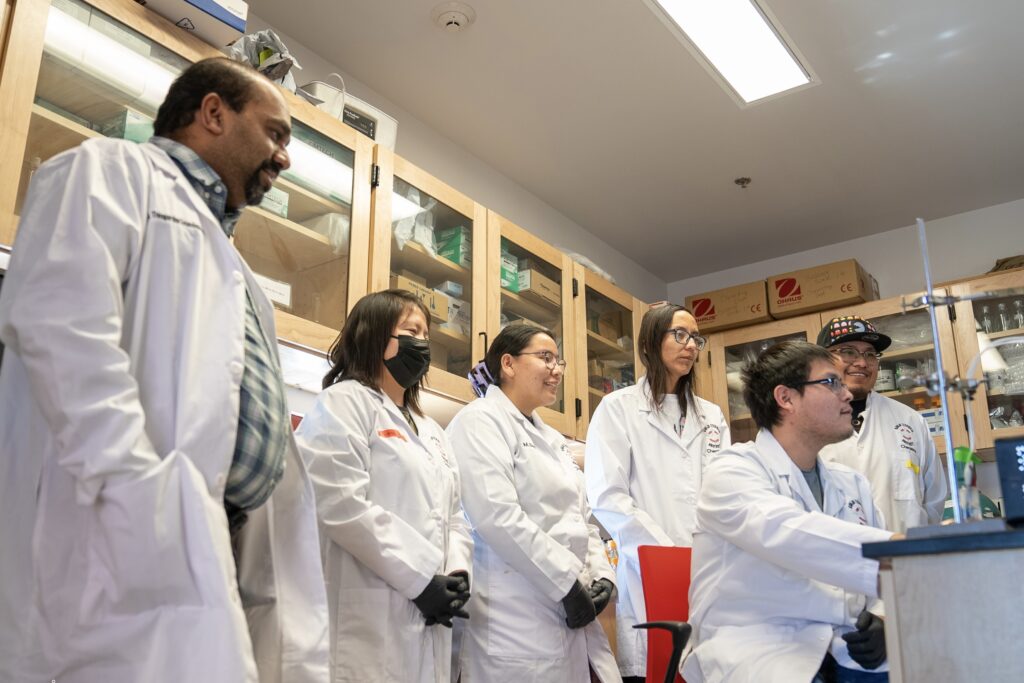Navajo Technical University’s collaboration with Harvard in materials research and science education is allowing students to pursue research that addresses real-world needs of the Navajo Nation
By Wafa Hozien

In 2017 Navajo Technical University and Harvard University’s Materials Research Science and Engineering Center established the Partnership in Research and Education in Materials program, providing Navajo students with opportunities to pursue advanced degrees in science and engineering. Led by Navajo Technical University Associate Professor of Chemistry Dr. Thiagarajan Soundappan, the collaboration addresses critical issues the Navajo nation faces by supporting groundbreaking research in health, agriculture and environmental monitoring.
The collaboration’s foundation was laid with National Science Foundation seed funding of $650,000 in 2018, which evolved into a $4.04 million funded proposal in 2021. The three thrust areas — microfluidic systems, electrochemical materials, energy storage and dynamic soft materials — showcase the depth of research conducted through this impactful partnership
According to Dr. Kathryn Hollar, director of community engagement and diversity outreach at Harvard University, the partnership is designed to create pathways for Navajo Technical University (NTU) students by combining Harvard’s expertise in research techniques with a focus on reinforcing the heritage of the Navajo people.
Hollar said the collaboration addresses legacy issues caused by mining and health disparities, offering students the opportunity to bridge their elders’ teachings with their academic studies at NTU, advocating for their community through science. Students explore applications such as soft robotics, electrochemical sensor techniques and microfluidics, addressing critical issues like groundwater and soil contamination from mining.
For instance, under the guidance of Harvard researchers, an electrochemistry research team at NTU, known as the Nanoelectrochemical Analysis and Energy Storages (NEST) Lab, has innovated paper-based electrochemical sensors capable of swiftly detecting heavy metals. These flexible and twistable sensors offer simplicity, affordability and portability, making them applicable across various sectors, including environmental monitoring, biomedical diagnostics, food safety testing and point-of-care diagnostics. The development of these sensors holds promise for monitoring heavy contaminants from abandoned mines and play a critical role in advancing healthcare diagnostic devices like glucose sensors, contributing significantly to the economic development of the Navajo Nation.
According to Dr. Jennifer Lewis, a member of Harvard University’s Wyss Institute for Biologically Inspired Engineering, the focus on research, teaching and community building has created a unique space for students to explore cutting-edge research while building strong relationships between NTU and Harvard faculty and students.
“This collaboration extends beyond the laboratory, providing NTU students with a unique urban experience in Boston,” Lewis said. “Through our joint efforts, we’re not only fostering research skills but also empowering students to bring valuable knowledge back to their communities, contributing to the growth of NTU as a technology hub.”
Dr. Soundappan’s incorporation of traditional Navajo knowledge into scientific research adds a unique dimension to the collaboration. Through the involvement of Dr. Franklin Sage in Diné Studies, students engage in traditional Navajo dye extraction. The extracted materials are then characterized using spectroscopic properties, showcasing the integration of cultural heritage with cutting-edge scientific research.

The collaboration between Navajo Technical University and Harvard University in materials research is making a profound impact on indigenous students—including Robinson Tom, NTU’s first biology program graduate and PREM participant. Admitted as the first Ph.D. student from NTU to Harvard, Tom’s research on microfluidic techniques for developing targeted bio-insecticides demonstrates the program’s real-world applications, especially in the agricultural industry—a cornerstone of the Navajo Nation’s economic landscape.
The program’s success is evident in the work of other students, as well:
- Wayant Billey, NTU’s first chemistry major, explores biofuel cells and automotive studies, aiming to revolutionize car fueling using biofuels and electric motors. Billey’s chemistry and environmental consciousness is evident as he envisions using paper-based electrodes to address health hazards related to coal mining and uranium mines on the Navajo Nation. Wayant aspires to pursue a doctorate degree in chemistry, bringing awareness and modern solutions to his community.
- Dallen Plummer, a prospective chemistry major who is currently an electrical engineering senior, is learning the ropes of electrochemical chemistry with a focus on paper electrodes. His work involves testing water samples on the Navajo Nation for hard metals, contributing to the larger goal of ensuring safe drinking water for both communities and livestock. Plummer hopes to graduate in electrical engineering, bringing his expertise to further NTU’s impact.
- Joshua Platero, an NTU graduate who is currently pursuing a MS in chemistry from Ohio State University, conducts electrochemistry research at NEST Lab, emphasizing its importance for Native American community health, focusing on fabricating paper-based electrochemical sensors to target biomolecules like glucose for improved patient monitoring, with aspirations to pursue a Ph.D. in chemistry for further research and development.
- Makeiyla Begay, a junior majoring in biology, studied at Kyoto Technical Institute in Japan over the summer, reflecting NTU’s global research collaborations, with a focus on biodegradable polymers and aspirations to become a veterinarian, inspired by NTU’s international partnerships and aiming to apply her research to animals, particularly focusing on the impact of heavy metals detection on animals consumed by Native Americans.
- Davina Spencer, a senior in Environmental Science and Natural Resources, conducts chemistry research to understand the elements in the Navajo Nation’s water and their health impact, driven to educate and improve lives by showcasing the importance of research in daily life, particularly in Indigenous communities.
- Katelyn Wilson, an NTU research assistant with a BS in biology, plays a crucial role in guiding interns, teaching them about research, and presenting their work at national conferences like the Society for Advancement of Chicanos/Hispanics and Native Americans in Science (SACNAS) and the American Indian Science and Engineering Society (AISES). Her dedication to biomolecular sensing research extends globally, with NTU earning recognition in competitions worldwide, notably through collaboration with Harvard.
These diverse voices exemplify the transformative influence of the Harvard-NTU collaboration, empowering Indigenous students to bridge traditional knowledge with cutting-edge research, creating solutions for their communities, and envisioning a future where science serves as a catalyst for positive change.
The project had to overcome barriers, particularly during the pandemic. Setting up local area networks on NTU’s campus and adapting to virtual engagement allowed for continued progress, Hollar said. From these challenges, a stronger partnership was forged.
“In the collaborative journey with NTU, we’ve witnessed the strength of bridging indigenous knowledge with cutting-edge scientific research,” she said. “Our students are not only learning about materials science but are becoming ambassadors, connecting their Navajo heritage with the forefront of scientific discovery.”
Dr. Jennifer Lewis concurs, noting that the emphasis on research at NTU is crucial, contributing to the university’s growth as a technology hub. The unique aspect of this collaboration lies in its commitment to empowering students to conduct meaningful research in their home environment. The growth of NTU from a small college to a thriving university is a remarkable outcome of this collaborative effort.
Looking ahead, Dr. Soundappan envisions the use of 3D printing to automate the fabrication of electrochemical sensors. This advancement would streamline the sensor production process and empower students with the latest technology in materials science.
The partnership between NTU and Harvard in materials research and science education stands as a model of success, blending academic excellence, cultural richness, and technological innovation. The shared vision for future advancements in materials research and science education at NTU reflects the enduring impact of this collaboration.
Wafa Hozien, Ph.D. is a university academic affairs. Dr. Hozien can be reached @wafahozien on Twitter and Instagram.
• • •
Enjoyed this story? Enter your email to receive notifications.
